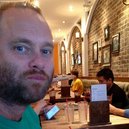Ripping It Up
I spent the weekend ripping strips for the Freedom. The stock wood I used was 9 boards of 6”x3/4”x19’, from old growth tight clear western red cedar. The wood was really nice but it presented a couple of minor problems. First, the wood was already planed but it had weathered on the faces. Secondly, it was all edge grain. This meant I had two options for ripping. First, I could rip 3/16” strips from the board and the resulting strips would be face grain with weathered edges. Secondly, I could first cut planks 7/8” wide and then try and rip 3 edge grain strips per plank.
I decided to cut a mix of the two methods. First I would cut a 1” plank, flip it and trim the other edge to 7/8”. If the grain had an interesting pattern I would keep ripping the board into face grain strips. On the other hand, if the grain wasn’t all that interesting, I would rip the 3 edge grain strips per plank. Even though I was using a thin kerf blade (a Freud Diablo 24 tooth blade), I still could only manage to get strips per blank if one of the faces was not planed or trimmed. In other words, the first strip I would rip would have 1 clean cut face and the other face (the one that slid along the fence) would remain untouched and weathered. The next two strips would end up with both faces cut, where the last strip would remove maybe only 1/64” of wood. In the end I ripped two boards into face grain and 7 boards into edge grain. For the strips that have a weathered face, I will glue these such that the face is on the outside and easier to sand. Hopefully it will work out okay. For the face grain strips that have weathered wood on the edges, since I’m stripping using a rolling bevel (ie using a plane to bevel the edge of each strip), the weathered wood will be removed during this process. After it was all said and done, I think I have about 140 strips where all but maybe 10 are full length.
At the same time I also cut some other wood. This includes ripping a 1x8x10’ AYC into strips, ripping some 1x6x12’ ash for gunwales, and ripping a 1x6x7’ walnut into strips. With the AYC and walnut I also split some of the strips into thinner ones about 1/4”x3/16”, and these can be used for some highlight/accent strips.
As for my table saw setup, I used board buddies with both bb set up in front of the blade. I think a more typical bb setup is one in front and one behind. However, I didn’t think this would work so well since I would be pushing a 3/16” side strip onto the bb on the outfeed side, and the bb could easily deflect such a thin piece of wood. I also experimented with adding a micro splitter jig to my zero clearance throat plate but one of two things prevented it from working: I either installed it incorrectly, or the splitter was too wide for the thin kerf blade I was using. I didn’t use the splitter in the end, I don’t really see a need for one. When I first installed the thin kerf blade I had some problems with blade wobble, but re-inserting the blade seemed to fix that.
For infeed and outfeed surfaces, I quickly rigged up a cheap setup. For the infeed I put my strongback boxbeam on my stands, and then put some 0.5”x12”x8’ melamine on top of the box beam. For the outfeed I slung another piece of melamine from the table to a stand, and then another piece from the stand to my ladder. I think I only used 2 clamps to hold everything together so it was quick to set up and take down. Nothing needs to be secured because there aren’t any real forces being exerted on these things. I then stuck some plywood under the feet of the table saw so that the saw matched the height of the infeed. The outfeed was lower and quite bowed because the melamine wasn’t supported very much, but that didn’t matter at all.
